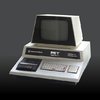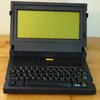denverpilot
Tied Down
With all the “retro” computing and gaming YouTube channels and such, I thought it might be fun to post up photos or mentions of old stuff you either OWNED or were issued for work.
It’d be weird to discuss mainframes and dumb terminals though, and yes I know a bunch of us did that.
More thinking from the “luggable” or laptop era and beyond ... and perhaps a favorite machine or theme in your personal preferences.
So I’ll start. I’ve been poking at the idea that it’s almost time for a new personal laptop. As I really looked hard at what I *actually* bought or wanted to use that was issued by work, I’m a dyed in the wool “small and light” laptop guy.
The laptop I probably used and loved the longest was a Toshiba Portege’ 3015CT. This is a photo of the 3010. Was just a software load difference.

Notice another formative thing. No trackpad and a track point type mouse. I love em. Nowadays that means Lenovo. Dell had something until recently but they killed it.
That Toshiba had raw Debian on it for years toward the end of its life and was waaaaay ahead of its time for lightness and thickness. Nothing came close.
There was a big fat personal “eMachines” laptop for a short while. It was huge. It didn’t last long as a regular driver for me.
Then another long stint with a company IBM Thinkpad T43. Freaking indestructible tank and again, track point. Oh and that traditional thinkpad keyboard that was real and not the total garbage modern keyboards, even Lenovo’s. Typists dream.
Still have these two kicking around. The time for fat and heavy is for rugged. Panasonic Toughbook. It’s here to program ancient radios that need real DOS. LOL.

And this was dad’s old Thinkpad X22. Still has XP and some dodgy ham radio software on it. Well almost all ham software is beyond dodgy. LOL.


Even have the docking station for that little guy.
Current work laptop is a boring Dell 15” with an 8th gen i5, bunch of RAM, and decent screen. Yawn. Works. Hate the touchpad.

And of course there’s an original black MacBook sitting in the closet and a very old but still occasionally used MacBook Pro with an early generation i7 kicking around. It’s honestly the fattest porker since the “eMachines” laptop.
Currently kinda lusting after the brand new HP Envy 13 with the new gen Ryzen 4000 series processor and of course, numerous Lenovos, just for the keyboard and “nipple mouse”. LOL.
Always liked anything with the old ThinkLight or backlit keyboards, too. Guess I turn lights off and tap away at night.
The X1 Carbon lineup at Lenovo is really tempting but the smaller X series also calls. And no AMD yet on the Carbon.
The downside of Ryzen for a little bit in laptops is even though Thunderbolt isn’t Intel proprietary anymore, it’ll take a bit to get it on AMD boxen. “USB 3.FiveMillion SuperSpeed+ Power Distribution from on board nuke plant” (oh what a stupid naming convention the USB people created...) has to do for now.
Of course NVMe and PCI speed SSDs are amazing these days along with DDR4 RAM and such. Quite a large number of machines with those being soldered on, with no upgrade path, for better or worse.
What were/are your favorite form factors in laptops?
By the way my penchant for the tiny ones includes a mandate that they dock or otherwise are useable with a “real” monitor, keyboard, and mouse at home. Sometimes I have a true desktop system at home and the lappie gets ignored, sometimes it’s the Swiss Army knife.
Not a huge “gamer” nor massive video editor, so not often using a monster home build desktop with a screaming GPU in it. But even the laptops need to be able to run a virtual machine or two.
It’d be weird to discuss mainframes and dumb terminals though, and yes I know a bunch of us did that.
More thinking from the “luggable” or laptop era and beyond ... and perhaps a favorite machine or theme in your personal preferences.
So I’ll start. I’ve been poking at the idea that it’s almost time for a new personal laptop. As I really looked hard at what I *actually* bought or wanted to use that was issued by work, I’m a dyed in the wool “small and light” laptop guy.
The laptop I probably used and loved the longest was a Toshiba Portege’ 3015CT. This is a photo of the 3010. Was just a software load difference.

Notice another formative thing. No trackpad and a track point type mouse. I love em. Nowadays that means Lenovo. Dell had something until recently but they killed it.
That Toshiba had raw Debian on it for years toward the end of its life and was waaaaay ahead of its time for lightness and thickness. Nothing came close.
There was a big fat personal “eMachines” laptop for a short while. It was huge. It didn’t last long as a regular driver for me.
Then another long stint with a company IBM Thinkpad T43. Freaking indestructible tank and again, track point. Oh and that traditional thinkpad keyboard that was real and not the total garbage modern keyboards, even Lenovo’s. Typists dream.
Still have these two kicking around. The time for fat and heavy is for rugged. Panasonic Toughbook. It’s here to program ancient radios that need real DOS. LOL.

And this was dad’s old Thinkpad X22. Still has XP and some dodgy ham radio software on it. Well almost all ham software is beyond dodgy. LOL.


Even have the docking station for that little guy.
Current work laptop is a boring Dell 15” with an 8th gen i5, bunch of RAM, and decent screen. Yawn. Works. Hate the touchpad.

And of course there’s an original black MacBook sitting in the closet and a very old but still occasionally used MacBook Pro with an early generation i7 kicking around. It’s honestly the fattest porker since the “eMachines” laptop.
Currently kinda lusting after the brand new HP Envy 13 with the new gen Ryzen 4000 series processor and of course, numerous Lenovos, just for the keyboard and “nipple mouse”. LOL.
Always liked anything with the old ThinkLight or backlit keyboards, too. Guess I turn lights off and tap away at night.
The X1 Carbon lineup at Lenovo is really tempting but the smaller X series also calls. And no AMD yet on the Carbon.
The downside of Ryzen for a little bit in laptops is even though Thunderbolt isn’t Intel proprietary anymore, it’ll take a bit to get it on AMD boxen. “USB 3.FiveMillion SuperSpeed+ Power Distribution from on board nuke plant” (oh what a stupid naming convention the USB people created...) has to do for now.
Of course NVMe and PCI speed SSDs are amazing these days along with DDR4 RAM and such. Quite a large number of machines with those being soldered on, with no upgrade path, for better or worse.
What were/are your favorite form factors in laptops?
By the way my penchant for the tiny ones includes a mandate that they dock or otherwise are useable with a “real” monitor, keyboard, and mouse at home. Sometimes I have a true desktop system at home and the lappie gets ignored, sometimes it’s the Swiss Army knife.
Not a huge “gamer” nor massive video editor, so not often using a monster home build desktop with a screaming GPU in it. But even the laptops need to be able to run a virtual machine or two.












 ). $10K, with mouse. Keyboard, video card, and monitor not included.
). $10K, with mouse. Keyboard, video card, and monitor not included. 






